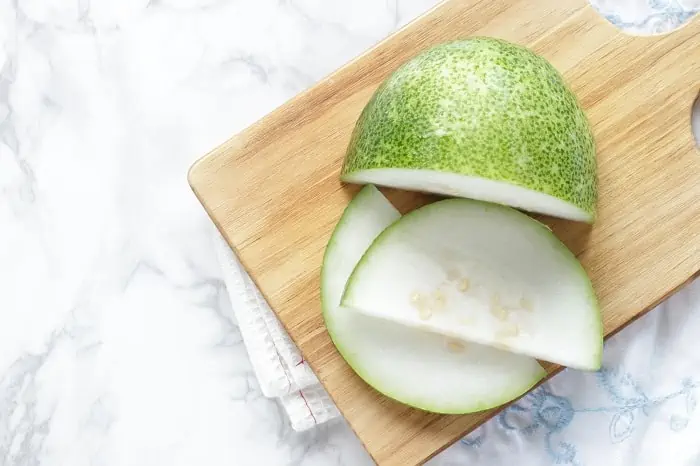Winter melon has a unique taste with mild sweetness and some almost indistinguishable flavors. This description may confuse you a little. Though mellow, this flavor occupies a solid space in Asian cultures. This simple fruit has won hearts with its unique taste and texture.
The green, grassy flavor of winter melon may remind you about watermelon rind. When cooked, it sets off a savory taste that enriches the taste. You can know more about what does winter melon taste like below.
Contrary to what you may think, raw winter melon tastes sweeter than ripe ones. A popular tea from Vietnam uses a sweetened version of this melon. This delectable flavor has now become a sensation all over the world. This fascinating fruit offers an umami-rich base for many soups.
What is Winter Melon
Winter melon belongs to the genus Benincasa and belongs to the cucurbit family. This fruit has many common names from different regions. Ash gourd, tallow gourd, white guard, puhul, and Chinese preserving melon stand as examples. Young melons have a hairy appearance that changes to a waxy coating on ripening.
When immature, winter melon has a thick flesh that gets softer with maturity. You can say that winter melon has more in common with squash. It grows from a vine that spreads on the soil. The waxy coating of ripe fruits provides an incredible shelf life of one year. The broad leaves and flowers of winter melon form an edible food source.
The skin of ripe winter melon has a dark-green color. It has a white-dusty appearance. Unripe melons have fuzzy hair covering. The flesh under the hard skin feels somewhat firm. Seeds have an enclosure of pulpy flesh. This part gets thrown away while the firm flesh enters the cooking phase.
Winter melon grows in the warm regions of the world. Available around the year, this fruit gets treated as a vegetable in cooking. It can grow as long as 80 cm in length. Like other squashes, winter melon also contains 95% of water to its weight.
Winter melon has water soluble fibers. They bring about a feeling of fullness in your stomach. This means that you can cut down on your food intake without feeling starving. It makes a great addition to your food platter to lose weight.
What Does Winter Melon Taste Like
Winter melon has a mellow taste with a slight sweetness. It has a grassy touch to its taste that shares some similarities with cucumber. The white flesh of ripe winter melons absorbs the flavor of its fellow ingredients. The pleasant taste and soothing texture of this fruit add more character to the dishes.
Asian cuisines use winter melon for preparing soups of different types. When cooked, the green taste of this melon gives way to savory flavor. Its flesh turns mushy and silky in texture. Though not strong, this taste conserves its individuality among other flavors. The bland nature of winter melon makes it a perfect pairing for sharp flavors.
You can use winter melon to make a variety of food items. Soups win the top-most point on this list of recipes. You can add it to any soup to make it richer in taste. The Chinese melon soup stands as a suitable example of this. Stir-fries and curries give you other delicious options to try winter melon.
An Indian sweet called Petha uses a candied form of winter melon. It has a sweet-savory taste with a firm but juicy structure. You may find it very hard to believe that Petha gets prepared from a vegetable. Kundol from the Philippines, Bakpia, and Chinese-wife-cakes forms other sweet delicacies using winter melon. Winter melon makes flavorous instant pickles due to its fast flavor-absorbing nature.
Winter melon has white flesh and seeds. The skin usually gets discarded, whereas you can consume the fried seeds. They have a nutty, earthy flavor. The fleshy part that holds the seeds also gets thrown away. This fruit doesn’t get eaten raw as it tastes bland. Cooked pieces of winter melon appear translucent and soft.
Winter melon has Vitamin C, antioxidants, and fibers. It offers a rich source of calcium, magnesium, zinc, and many other nutrients. They can contribute to your overall well-being. Winter melon can form a delectable addition to the diet plan of health freaks.
What Does Winter Melon Tea Taste Like
Winter melon tea originates from Vietnam. This sweet tea can help you beat hot weather by cooling you down. It uses the melon fruit in the place of tea leaves to brew the tea. It combines the distinctive taste of the fruit and caramel favor from reduced sugar.
Sliced pieces of winter melon get boiled in water. Then cook it well with brown sugar and caramel for hours. After cooling down, this mixture gets filtered and refrigerated. This syrup can be further dehydrated to form solid punch cubes. Home-made concentrates can last up to three weeks in refrigerators.
Soaking winter melon cubes in lime helps to preserve its authentic flavor. These hard cubes then get simmered with sugar to prepare tea. You can mix other flavors or teas with this to create new appealing blends. People prepare sugar-free winter melon tea by removing sugar solutions from the preparation.
Conclusion
Winter melon has a grassy, sweet, but faint taste that may appear bland. Sweetness reduces when it ripens. This fruit belongs to the squash family and has white flesh and dark, dusty skin. People don’t usually eat winter melon raw. When boiled, the hard part of this fruit transforms into smooth flesh.
Winter melon absorbs flavors from ingredients and enriches the food. You can use it to deepen the savory flavor. This fruit resembles watermelon rind in taste. Winter melon tea, a beloved summer drink from Vietnam, uses caramelized fruit syrup. This magic cucurbit forms soups, sweets, stir-fries, and many more intriguing food items.

